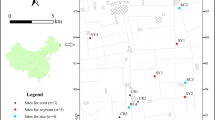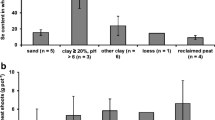Abstract
Aims
A comparison was performed between plant species to study Se accumulation and translocation in the crops under field condition.
Methods
Wheat, rice and canola were sampled with respective cultivated soils from the Yangtze River Delta area. The concentrations of total Se and bio-available Se and a number of parameters (N, P, S, Fe, Ca, Mg, Al, K, Mn, pH and organic carbon) were analyzed, and the net translocation coefficients of Se in the soil-crop systems were calculated.
Results
The concentrations of Se in plants significantly differed between crop species, in spite of concentrations of total Se and bio-available Se and related parameters in the soils showing no significant difference among the wheat, rice and canola sampled sites. With regard to the seeds, wheat exhibited significantly higher Se concentration than rice and canola; whereas for the straw and root, wheat showed lower Se concentration than canola and rice. The net translocation coefficients of Se in different soil-crop systems exhibited different patterns, suggesting that the difference is mainly caused by a discrepancy in Se translocation from straw to grain.
Conclusions
Wheat has a weaker capability to accumulate Se compared with rice and canola, but a significantly stronger capability to transport Se from its straw to seed. These differences might be related to the influence of S on Se differences, comparing the biochemical behavior and transport of S and Se in plants of different plant species. Selenium follows sulfur during accumulation in wheat and rice because both elements are accumulated in plant tissues mainly in the form of amino acids; whereas in canola, the influence of S on Se accumulation is not as obvious as in wheat and rice because the seeds contain more non-amino acid organic S compounds.




Similar content being viewed by others
Abbreviations
- BI:
-
Bio-accumulation index
- NTC:
-
Net translocation coefficient
- OC:
-
Organic carbon
- SeCys:
-
Selenocysteine
- SeMet:
-
Selenomethionine
- WS-Se:
-
Water-soluble Se
References
Bremner JM (1996) Nitrogen-total. In: Sparks DL (ed) Methods of soil analysis, part 3, chemical methods. SSSA, Madison, p 10851121
Cao Z, Wang X, Yao D, Zhang X, Wong M (2001) Selenium geochemistry of paddy soils in Yangtze River Delta. Environ Int 26:335–339
Christophersen OA, Lyons G, Haug A, Steinnes E (2012) Selenium. In: Alloway BJ (ed) Heavy metals in soils: trace metals and metalloids in soils and their bioavailability, 3rd edn. Springer, Dordrecht, pp 429–463
De Temmerman L, Waegeneers N, Thiry C, Laing GD, Tack F, Ruttens A (2014) Selenium content of Belgian cultivated soils and its uptake by field crops and vegetables. Sci Total Environ 468-469:77–82
Dhillon KS, Dhillon SK (2009) Selenium concentrations of common weeds and agricultural crops grown in the seleniferous soils of northwestern India. Sci Total Environ 407:6150–6156
Durán P, Acuña JJ, Jorquera MA, Azcón R, Borie F, Cornejo P, Mora ML (2013) Enhanced selenium content in wheat grain by co-inoculation of selenobacteria and arbuscularmycorrhizal fungi: a preliminary study as a potential Se biofortification strategy. J Cereal Sci 57:275–280
Fan M, Zhao F, Poulton PR, McGrath SP (2008) Historical changes in the concentrations of selenium in soil and wheat grain from the Broadbalk experiment over the last 160 years. Sci Total Environ 389:532–538
Galinha C, Sánchez-Martínez M, Pacheco AMG, Freitas M, Coutinho J, Maçãs B et al (2015) Characterization of selenium-enriched wheat by agronomic biofortification. J Food Sci Technol 52:4236–4245
Hartikainen H (2005) Biogeochemistry of selenium and its impact on food chain quality and human health. J Trace Elem Med Biol 18:309–318
Haug A, Graham RD, Christophersen OA, Lyons GH (2007) How to use the world’s scarce selenium resources efficiently to increase the selenium concentration in food. Microb Ecol Health Dis 19:209–228
Hawkesford MJ, Zhao FJ (2007) Strategies for increasing the selenium content of wheat. J Cereal Sci 46:282–292
Huhtanen P, Hetta M, Swensson C (2011) Evaluation of canola meal as a protein supplement for dairy cows: a review and a meta-analysis. Can J of Anim Sci 81:529–543
Johnsson L (1991) Selenium uptake by plants as a function of soil type, organic matter content and pH. Plant Soil 133:57–64
Kabata-Pendias A (2011) Trace elements in soils and plants, 4th edn. CRC Press, Boca Raton
Keskinen R, Turakainen M, Hartikainen H (2010) Plant availability of soil selenate additions and selenium distribution within wheat and ryegrass. Plant Soil 333:301–313
Kikkert J, Hale B, Berkelaar E (2013) Selenium accumulation in durum wheat and spring canola as a function of amending soils with selenite, selenate and or sulphate. Plant Soil 372:629–641
Lee S, Woodard HJ, Doolittle JJ (2011) Effect of phosphate and sulfate fertilizers on selenium uptake by wheat (Triticum aestivum). Soil Sci Plant Nutr 57:696–704
Leustek T, Saito K (1999) Sulfate transport and assimilation in plants. Plant Physiol 120:637–643
Li N, Gao Z, Luo D, Tang X, Chen D, Hu Y (2007a) Selenium level in the environment and the population of Zhoukoudian area, Beijing. China. Sci Total Environ 381:105–111
Li Y, Dong Y, Zheng J, Xie H, Song M (2007b) The transport and transformation of selenium in the soil-paddy plant system affected by geological factors. Geophys Geochem Explor 31(1):77–80
Li H, McGrath SP, Zhao F (2008) Selenium uptake, translocation and speciation in wheat supplied with selenate or selenite. New Phytol 178:92–102
Liu HY, Probst A, Liao BH (2005) Metal contamination of soils and crops affected by the Chenzhou lead/zinc mine spill (Hunan, China). Sci Total Environ 339:153–166
Mattina MI, Lannucci-Berger W, Musante C, White JC (2003) Concurrent plant uptake of heavy metals and persistent organic pollutants from soil. Environ Pollut 124:375–378
Nelson DW, Lee ES (1996) Total carbon, organic carbon, and organic matter. In: Sparks DL et al (eds) Methods of soil analysis, part 3, chemical methods. SSSA, Madison, pp 971–976
Pilon-Smits EAH, Quinn CF (2010) Selenium metabolism in plants. In: Hell R, Mendel R-R (eds) Cell biology of metals and nutrients. Springer, Berlin/Heidelberg, pp 225–241
Saha UK, Liu C, Kozak LM, Huang PM (2005) Kinetics of selenite desorption by phosphate from hydroxyaluminium and hydroxyaluminosilicate-montmorillonite complexes. Geoderma 124:105–119
Shewry PR (2007) Improving the protein content and composition of cereal grain. J Cereal Sci 46:239–250
Sors TG, Ellis DR, Salt DE (2005) Selenium uptake, translocation, assimilation and metabolic fate in plants. Photosynthesis Res 86:373–389
Steinbrenner H, Sies H (2009) Protection against reactive oxygen species by selenoproteins. Biochim Biophys Acta 1790(11):1478–1485
Stroud JL, Li HF, Lopez-Bellido FJ, Broadly MR, Foot I (2010) Impact of Sulphur fertilization on crop response to selenium fertilization. Plant Soil 332:31–40
Sun W, Huang B, Zhao Y, Shi X, Darilek J, Deng X, Wang H, Zou Z (2008) Spatial variability of soil selenium as affected by geologic and pedogenic processes and its effect on ecosystem and human health. Geochem J 43:217–225
Sun G, Liu X, Williams PN, Zhu Y (2010) Distribution and translocation of selenium from soil to grain and its speciation in paddy rice (Oryza sativa L.). Environ Sci Technol 44:6706–6711
Sun G, Meharg AA, Li G, Chen Z, Yang L, Chen S, Zhu Y-G (2016) Distribution of soil selenium in China is potentially controlled by deposition and volatilization? Sci Rep 6:20953
Tan J, Zhu W, Wang W, Li R, Hou S, Wang D, Yang L (2002) Selenium in soil and endemic diseases in China. Sci Total Environ 284:227–235
Tanhan P, Kruatrachue M, Pokethitiyook P, Chaiyarat R (2007) Uptake and accumulation of cadmium, lead and zinc by Siam weed [Chromolaena odorata (L.) King & Robinson]. Chemosphere 68:323–329
Terry N, Zayed AM, de Souza MP, Tarun AS (2000) Selenium in higher plants. Annu Rev Plant Physiol Plant Mol Biol 51:401–432
Trischuk RG, Schilling BS, Low NH, Gray GR, Gusta LV (2014) Cold acclimation, de-acclimation and re-acclimation of spring canola, winter canola and winter wheat: the role of carbohydrates, cold-induced stress proteins and vernalization. Environ Exp Botany 106:156–163
USDA (2006) Foreign agricultural service global agriculture information network report CH6064. Peoples Republic of fairs product specific maximum levels of contaminants in foods, China
Wang J, Wang Z, Mao H, Zhao H, Huang D (2013b) Increasing Se concentration in maize grain with soil- or foliar-applied selenite on the loess plateau in China. Field Crops Res 150:83–90
Wang C, Ji J, Yang Z, Chen L (2013a) The contamination and transfer of potentially toxic elements and their relations with iron, vanadium and titanium in the soil-rice system from Suzhou region, China. Environ Earth Sci 68:13–21
Wang Q, Zhang J, Zhao B, Xin X, Deng X, Zhang H (2016) Influence of long-term fertilization on selenium accumulation in soil and uptake by crops. Pedosphere 26:120–129
Whetter PA, Ullrey DE (1978) Improved fluorometric method for determining selenium. J Assoc Anal Chem 61:927–930
White PJ, Bowen HC, Marshall B, Broadley MR (2007) Extraordinarily high leaf selenium to sulfur ratios define ‘Se-accumulator’ plants. Ann Bot London 100:111–118
Williams PN, Lombi E, Sun G, Scheckel K, Zhu Y, Feng X, Zhu J, Carey A-M, Adomako E, Lawgali Y, Deacon C, Meharg AA (2009) Selenium characterization in the global rice supply chain. Environ Sci Technol 43:6024–6030
Winkel LHE, Vriens B, Jones GD, Schneider LS, Pilon-Smits E, Bañuelos GS (2015) Selenium cycling across soil-plant-atmosphere interfaces: a critical review. Nutrients 7:4199–4239
Zhang H, Feng X, Zhu J, Sapkota A, Meng B, Yao H et al (2012) Selenium in soil inhibits mercury uptake and translocation in rice (Oryza sativa L.). Environ Sci Technol 46:10040–10046
Zhang H, Feng X, Jiang C, Li Q, Liu Y, Gu C et al (2014) Understanding the paradox of selenium contamination in mercury mining areas: high soil content and low accumulation in rice. Environ Pollut 188:27–36
Zhao C, Ren J, Xue C, Lin E (2005) Study on the relationship between soil selenium plant selenium uptake. Plant Soil 2005(277):197–206
Zhu J, Wang N, Li S, Li L, Su H, Liu C (2008) Distribution and transport of selenium in Yutangba, China: impact of human activities. Sci Total Environ 392:252–261
Zhu Y-G, Pilon-Smits EAH, Zhao F-J, Williams PN, Meharg AA (2009) Selenium in higher plants: understanding mechanisms for biofortification and phytoremediation. Trends Plant Sci 14:436–442
Acknowledgements
This study was funded by the Natural Science Foundation of Jiangsu Province of China (Grants No BK20160947 and BK20150915) and National Natural Science Foundation of China (Grants No 41503099 and 41501197).
Author information
Authors and Affiliations
Corresponding authors
Additional information
Responsible Editor: Robert Reid.
Rights and permissions
About this article
Cite this article
Wang, C., Ji, J. & Zhu, F. Characterizing Se transfer in the soil-crop systems under field condition. Plant Soil 415, 535–548 (2017). https://doi.org/10.1007/s11104-017-3185-1
Received:
Accepted:
Published:
Issue Date:
DOI: https://doi.org/10.1007/s11104-017-3185-1




